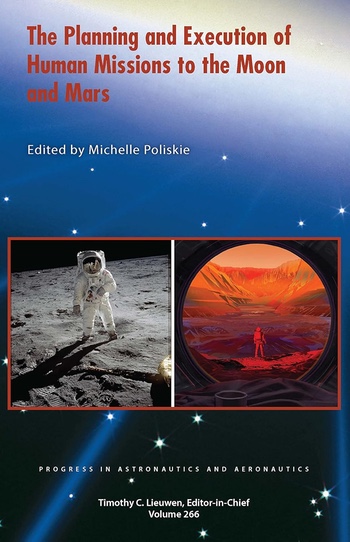So you want to go to Mars: Where do you start?by Jonathan Coopersmith
|
| While the many engineering challenges receive the most attention, “The greatest opportunity or threat for any large-scale, long-term technological program is political change.” |
Published by the American Institute of Aeronautics and Astronautics (AIAA) and edited by Michelle Poliskie, its 16 chapters provide an excellent checklist for issues that Mars astronauts, their vast supporting team, policymakers, and citizens should read to ensure that, if the decision to proceed is made, the effort will have a greater chance of success including, most importantly, broad public support. And failure is definitely an option: of the 63 robotic missions launched between 1963 and 2024, 32% failed within a year.
The chapters range from historical efforts and proposals (17 from 1987 to 2015) to go to Mars to the major technological challenges, unknowns, and paths to explore. Many are obvious: How do you keep astronauts alive, physically and mentally healthy, and supplied with reliable equipment? Some are less obvious: While the many engineering challenges receive the most attention, “The greatest opportunity or threat for any large-scale, long-term technological program is political change.”
And politically, the continued but decreased White House support after Apollo for astronauts in space through the Space Shuttle and what became the International Space Station (ISS) reflects that no president wanted to be known as the person who stopped America from sending astronauts into space. The need for humans in space is rarely discussed. Notice, however, the part of the federal government whose needs could best justify spending to send astronauts, the military, has no known astronaut program despite several efforts over the decades.
The chapters provide a very good overview of various technologies, mission options, and policies that should be discussed and ideally resolved before proceeding. Chapters on the obvious technologies like habitats, propulsion, and ECLSS (environmental control and life support systems) but also on program management, mission architectures, and interplanetary supply chains and logistics.
Former Secretary of Defense Donald Rumsfeld would have been thrilled at the discussions of known knowns, known unknowns, and, most worryingly for a multimillion-kilometer and multi-month trip, unknown unknowns. Even feeding the crew has multiple challenges.
The 15 pages of abbreviations and hundreds of footnotes illustrate the seriousness of this effort. Unsurprisingly, maintaining human health created the most footnotes (271), reflecting the need, uncertainty and challenges. Mission aborts had the least (15).
Although not covered, policymakers should be aware: Wars are not good for human spaceflight. Both are expensive ventures and the needs of the former will destroy possibilities for the latter. The most developed American proposals to go to Mars—Vice President Spiro Agnew’s 1969 Space Task Group Report and President George W. Bush’s 2004 Vision for Space Exploration—died early partially because of American involvement in wars in Vietnam and Iraq respectively.
The AIAA deserves credit for publishing this vade mecum for engineers, policymakers, and the public. If nothing else, the Congressional space committees should use this volume to ask necessary questions of proposals.
Note: we are now moderating comments. There will be a delay in posting comments and no guarantee that all submitted comments will be posted.
